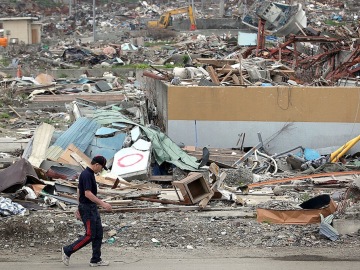Could an Earthquake 'Invisibility Cloak' Shield Buildings from Damage?
 SAN FRANCISCO – Earthquake cloaks, or huge arrays of precisely drilled holes and trenches in the ground, could — at least in theory — protect important structures like nuclear power plants from powerful seismic waves, researchers say.
SAN FRANCISCO – Earthquake cloaks, or huge arrays of precisely drilled holes and trenches in the ground, could — at least in theory — protect important structures like nuclear power plants from powerful seismic waves, researchers say.
The array of holes, drilled at specific angles and depths, would extend sometimes hundreds of feet and scatter earthquake waves like pinballs, according to the scientists.
The idea is still highly speculative, requires a large amount of space that might be impractical, and has not been tested in the ground, but if it works, it could theoretically be used to protect expensive infrastructure that cannot be seismically retrofitted, such as oil pipelines, Vladimir Liberman, a physicist at the Massachusetts Institute of Technology Lincoln Laboratory, said here Thursday (Dec. 15) at the annual meeting of the American Geophysical Union.
Protecting vulnerable structures
In places like Oklahoma, oil and gas production has caused swarms of man-made earthquakes, meaning expensive infrastructure such as oil pipelines are now in vulnerable locations. In other areas, nuclear power plants are vulnerable to strong earthquakes. Sometimes, this infrastructure can't actually be physically modified to make it more resistant to earthquakes, Liberman said.
But what if seismic waves could be deflected before they reach critical infrastructure? To see if there was another way to protect these structures, Liberman and his colleagues created a 3D simulation where they modeled the ground in tiny, three-dimensional cubes, or chunks that varied in size. The model then incorporated drilled holes of varying sizes and orientations, forming a kind of underground zigzag shape. They modeled seismic waves coming from different orientations and found that in computer simulations at least, their setup could deflect a large amount of the energy coming from earthquake waves, Liberman said.
Next, they created a tabletop mockup of the ground using a small block of plastic fitted with tiny accelerometers and drilled with lots and lots of holes in precise orientations, then subjected them to mock seismic waves. The plastic had the right set of physical parameters, such as shear wave velocity and viscosity, to mimic ground-based seismic waves. Similar to their model predictions, the mockup deflected the incoming waves. Based on these experiments, the team thinks its earthquake-cloaking method could reduce the impact from a magnitude-7.0 quake to a magnitude 5.0 or even lower, Liberman said.
Earthquake deflection
Based on these simulations, the scientists estimated that protecting infrastructure such as nuclear power plants, hospitals, air vehicle runways and pipelines would take anywhere from 2,000 to 8,000 boreholes drilled at precise angles, spanning hundreds of feet, and placed a distance up to a few miles away from the infrastructure, Liberman said.
Of course, there are a number of caveats: The method hasn't been subject yet to peer review, and the researchers have yet to test it in real-world situations, against actual seismic waves. In addition, there's no telling yet whether deflecting these earthquake waves would lead to dangerous wave reflections to other areas, Liberman said. And given how much space is needed to create these earthquake cloaks, it is likely only practical for structures far away from urban areas, he said. Still, when talking about $2 billion in infrastructure, it can be relatively economical to drill a field of holes at a cost of about $100,000 to protect those structures, he added.
As the next step in their research, the team is testing out the earthquake-cloaking concept on a small scale in the ground using machines that generate vibrations.
One of the moderators of the session asked whether more visually appealing structures, such as trees, could replace boreholes while serving the same earthquake deflection process.
Unfortunately, the trees would have to be extremely tall, Liberman said.
"You would need mini-Eiffel Towers to attenuate the low frequency waves" that accompany earthquakes, Liberman said.
